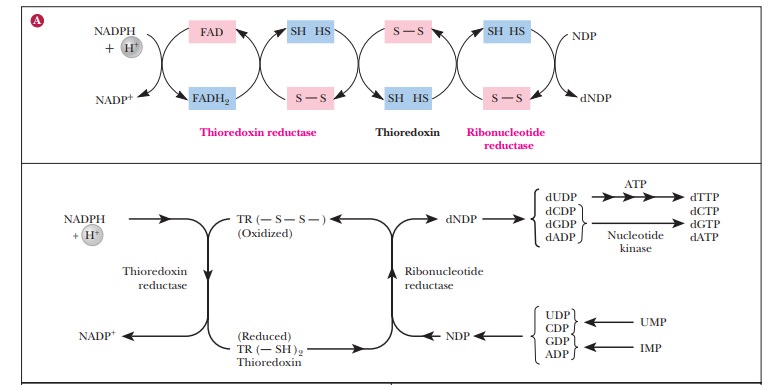Chapter: Biochemistry: The Metabolism of Nitrogen
Conversion of Ribonucleotides to Deoxyribonucleotides

Conversion of Ribonucleotides to
Deoxyribonucleotides
Ribonucleoside
diphosphates are reduced to 2'-deoxyribonucleoside diphos-phates in all
organisms (Figure 23.31a); NADPH is the reducing agent.
Ribonucleoside diphosphate + NADPH + H+ -> Deoxyribonucleoside diphosphate + NADP+ + H2O
The actual process, which is catalyzed by ribonucleotide reductase, is more complex than the preceding equation would indicate and involves some intermediate electron carriers. The ribonucleotide reductase system from E.coli has been extensively studied, and its mode of action gives some clues tothe nature of the process. Two other proteins are required, thioredoxin and thioredoxin reductase. Thioredoxin contains a disulfide (S—S) group in its oxidized form and two sulfhydryl (—SH) groups in its reduced form. NADPH reduces thioredoxin in a reaction catalyzed by thioredoxin reductase. The reduced thioredoxin in turn reduces a ribonucleoside diphosphate (NDP) to a deoxyribonucleoside diphosphate (dNDP), shown in Figure 23.31b, and this reaction is actually catalyzed by ribonucleotide reductase. Note that this reaction produces dADP, dGDP, dCDP, and dUDP. The first three are phosphorylated to give the corresponding triphosphates, which are substrates for the synthesis of DNA. Another required substrate for DNA synthesis is dTTP, and we shall now see how dTTP is produced from dUDP.


Summary
NADPH serves as the ultimate reducing agent in a process that
requires several enzymes and intermediate electron carriers.
Related Topics